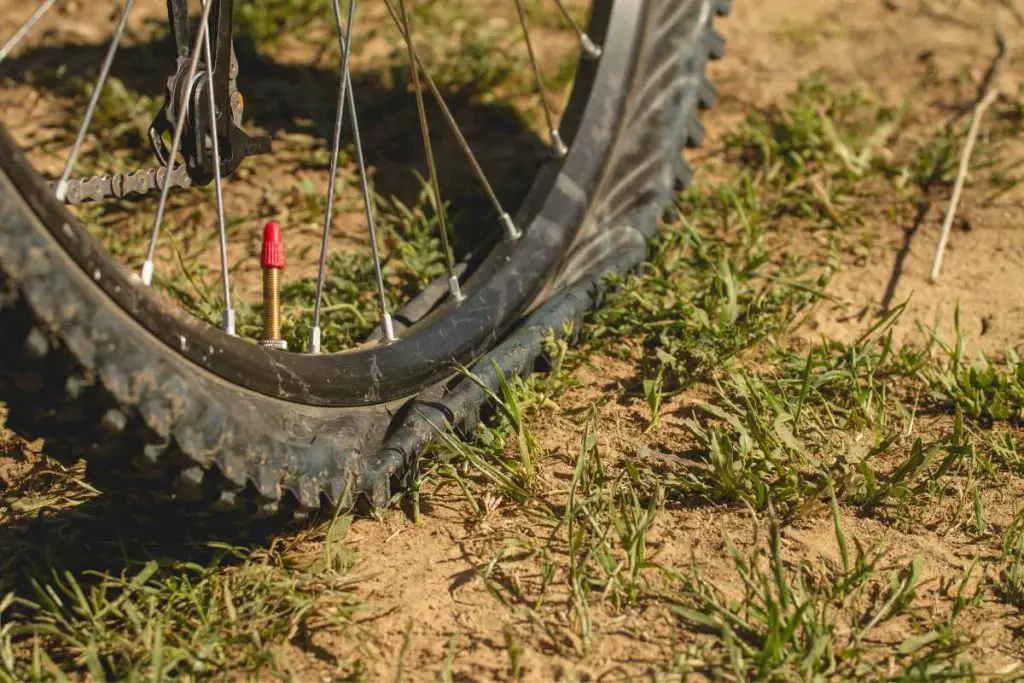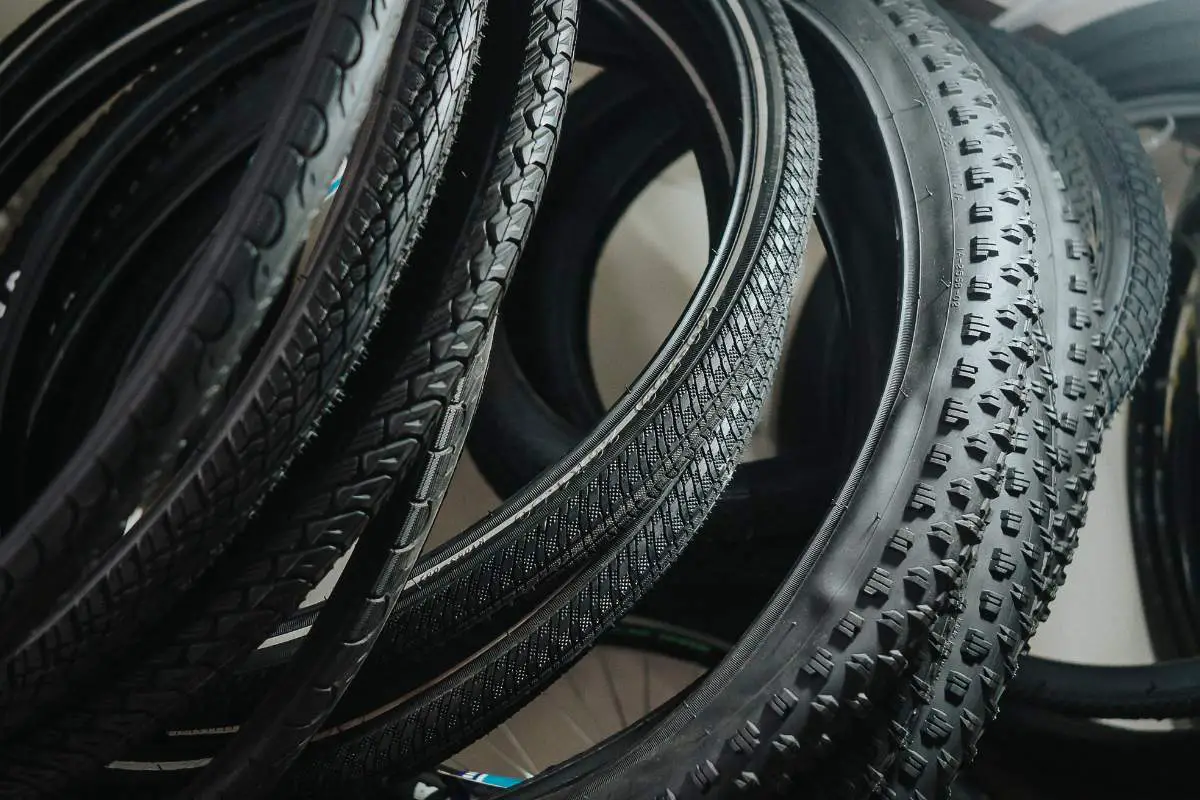Mountain biking is a thrilling and physically demanding sport that requires the right equipment to perform at your best and stay safe.
One crucial piece of equipment that often gets overlooked is the mountain bike tire. Tires connect you to the ground and are essential for traction, stability, and control on the trails.
So, when should mountain bike tires be replaced? As soon as you notice any signs of wear and tear, such as shallow treads, nicks or cuts in the tire, or bulging sidewalls
Worn-out tires can affect your bike’s performance, safety, and overall enjoyment of your ride.
In this article, we will also explore what happens when a tire is worn out, how to make mountain bike tires last longer, and how to select the correct mountain bike tires for your needs.
Worn-out tires can affect your bike’s performance, safety, and overall enjoyment of your ride.
Signs that you’re MTB Tires Are Worn Out
There are a few key signs that your mountain bike tires are worn out and in need of replacement:
Knobs Worn Flat
One of the easiest ways to tell if your mountain bike tires are worn out is to look at the tread. If the knobs on the tire are worn down or flat, it’s time to replace it.
A tire with worn tread will provide less traction than a new tire, which can be dangerous on rough or slippery trails.
Tire Depth Gauge
A tire depth gauge is a tool that measures the depth of the tread on your mountain bike tires. If the tread depth is less than 2mm, it’s time to replace the tire.
Holes or Gashes in the Tire
If you notice any holes or gashes in your mountain bike tire, it’s crucial to replace it as soon as possible. These damages can cause flats and can be dangerous to ride on.
Bumps or Blisters In the Tire
Bumps or blisters on the tire’s surface may indicate that the tire is damaged or has been ridden for too long. It’s crucial to replace the tire if you notice any of these issues.
Cracking in the Rubber
If you notice any cracking in the rubber of your mountain bike tire, it’s a sign that the tire is old and needs to be replaced. Cracking can cause the tire to fail and can be dangerous to ride on.
read.. oil the chain how often
No Tire Traction!
If you are slipping or sliding more than usual on the trails, it could be a sign that your mountain bike tires are worn out. New tires will provide better traction and improve your ride experience.
Worn Sidewalls
In addition to checking the tread, inspecting the sidewalls of your mountain bike tires is important. If the sidewalls are worn or frayed, it’s time to replace the tire.

What Happens When a Tire is Really Worn Out?
Riding on worn-out mountain bike tires can have serious consequences. Worn-out tires can cause poor traction, leading to accidents and injuries.
In addition, worn-out tires can cause flats and other mechanical issues, which can ruin your ride and be costly to repair.
“…After about 500–1000 miles, there will be enough wear that your grip is diminished, especially when cornering and in loose or steep terrain. While tires can be pushed past this wear level, many riders opt to simply replace at this point. Old tires are more vulnerable to punctures…”
Source: https://mbaction.com/wear-and-tear-when-you-should-replace-your-mountain-bike-tires-and-why/
How to Make MTB Tires Last Longer
There are a few things you can do to extend the life of your mountain bike tires:
Proper tire pressure: Keeping your tires at the correct pressure can help extend their life. Underinflated tires can wear out faster, while overinflated tires can be more prone to punctures.
Proper tire rotation: Rotating your tires can help evenly distribute wear and tear.
Avoid sharp objects: Avoid riding over sharp objects like rocks and sticks, as they can cause punctures and damage your tires.
Clean and lubricate: Keeping your tires clean and lubricated can help prevent wear and tear.
read.. when to replace the sealant in my tubeless mountain bike tires
How to Select the Correct Mountain Bike Tires
When it comes to selecting the right mountain bike tires, there are a few key factors to consider:
Wheel Size
The first thing to consider is the size of your wheels. Mountain bike tires come in various sizes to fit different wheel sizes. Make sure to choose tires that are compatible with your wheels.
Tire Width
The width of your mountain bike tires can affect your ride experience. Wider tires can provide more traction and stability but may also be heavier and slower to accelerate.
Narrower tires may be lighter and faster but provide less traction and stability.
Tire Tread
The tread of your mountain bike tires can also impact your ride experience. Tires with more aggressive tread patterns are better suited for off-road conditions, while tires with smoother tread patterns are better for pavement and hard-packed trails.
Type of Tire
There are several mountain bike tires, including clincher, tubeless, and tubular. Clincher tires are the most common and are easy to install and repair.
Tubeless tires offer improved traction and a smoother ride but can be more challenging to install and repair.
Tubular tires are typically reserved for racing and offer low rolling resistance and a smooth ride but are more expensive and difficult to install and repair.
Video: When to Replace MTB Tires
Take Away
It’s important to regularly check your mountain bike tires and replace them when necessary.
Pay attention to the signs that your tires are worn out, such as flat knobs, holes or gashes, bumps or blisters, cracking in the rubber, and worn sidewalls.
Worn-out tires can lead to poor traction, a danger on rough or slippery trails, and mechanical issues, which can ruin your ride.
They are also more susceptible to flats and other mechanical problems.
Pick the right mountain bike tires by choosing the correct size and type of tire, keeping them at the correct pressure, rotating them regularly, avoiding sharp objects on the trail, cleaning and lubricating them when needed, and replacing them when they have reached the end of their useful life.
Properly maintaining and selecting the right mountain bike tires can help improve your ride experience and keep you safe on the trails.

